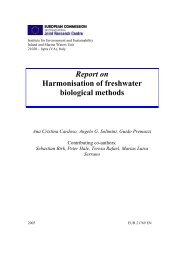Lakes and Watercourses
Lakes and Watercourses
Lakes and Watercourses
You also want an ePaper? Increase the reach of your titles
YUMPU automatically turns print PDFs into web optimized ePapers that Google loves.
conditions for watercourse flora <strong>and</strong> fauna. No specific scales are given<br />
for assessing concentrations of nitrogen or phosphorus in watercourses;<br />
it is expected that these will be evaluated having been converted in areaspecific<br />
losses. Instructions for conversion are given with the scales in<br />
question.<br />
High concentrations of nitrate in drinking water can constitute a<br />
health problem <strong>and</strong> the National Food Administration defines drinking<br />
water as ”fully fit for consumption” when nitrate concentrations are<br />
below 10 mg NO3-N/l. Assessment scales for nitrate are not given here,<br />
however.<br />
Ammonium is converted into molecular ammoniac in an equilibrium<br />
reaction at high pH levels. The risk of fish <strong>and</strong> other aquatic organisms<br />
being poisoned rises rapidly at high ammonium concentrations at pH<br />
level exceeding about 8. Calculation methods <strong>and</strong> criteria for toxicity to<br />
fish <strong>and</strong> other aquatic organisms have been published (see references).<br />
Assessment scales for ammoniac are not given here.<br />
Assessment of current conditions<br />
TABLE 2.<br />
CURRENT CONDITIONS: concentration of total phosphorus<br />
in lakes (µg/l)<br />
Class Description Concentration Concentration<br />
May – October August<br />
1 Low concentrations ≤ 12.5 ≤ 12.5<br />
2 Moderately high concentrations 12.5 – 25 12.5 – 23<br />
3 High concentrations 25 – 50 23 – 45<br />
4 Very high concentrations 50 – 100 45 – 96<br />
5 Extremely high concentrations > 100 Not defined<br />
Concentrations are given as seasonal mean (May – October) over one<br />
year based on monthly readings taken in the epilimnion or, if only one<br />
sample is taken, surface water (0.5 m). The concentration of total phosphorus<br />
displays little seasonal variation at lower concentration ranges<br />
<strong>and</strong> an assessment can also be made of concentrations recorded in<br />
August as shown above, although it should then be assessed as a mean<br />
figure over three years. Late summer concentrations vary enormously at<br />
extremely high concentrations <strong>and</strong> seasonal mean figures should be used<br />
to make an assessment. The classes relate to various production levels<br />
long used by limnologists, principally determined by the phosphorus<br />
20















![Accommodation booking form [PDF]](https://img.yumpu.com/39471785/1/184x260/accommodation-booking-form-pdf.jpg?quality=85)

